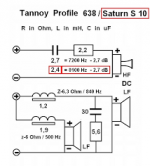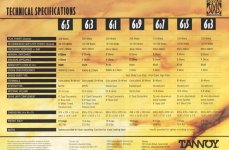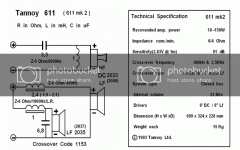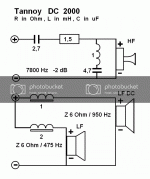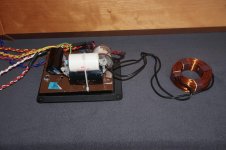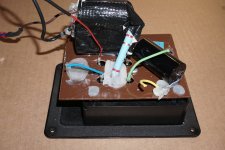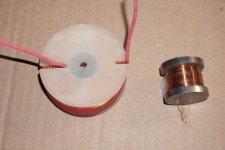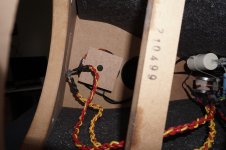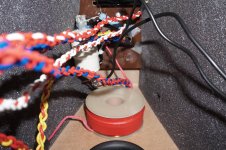You'll find a larger copy of the Tannoy 611 crossover schematic here: Tannoy DC1000/2000 Crossover
This should put the crossover wiring into perspective.
This should put the crossover wiring into perspective.
Thanks a lot! It's a bit hard to read, though: is that a 6.8 uF in the 2nd order lowpass?Compare this Tannoy crossover (8" dual concentric driver / 8" low frequency driver) which has crossover frequencies of 400Hz and 2,500Hz.
This speaker appears to be at least similar to my D500, looking at the drivers. Just the highpass section is a 2nd order type, while I found a 1st order in my D500. One similarity, though, is the 3.3 uF (correct value?) in the 611 highpass and the 2.2 uF in my D500 highpass. This leads me to another question: could it be that originally there was a 2nd order highpass in my D500, just modified to a 1st order and stopping work on half way? Just adding a 1mH coil to the D500 layout should result in a 2nd order highpass somewhere around the crossover frequency of 1700 Hz, as reported.
I think this is something I should ask the guy who modified it nearly 20 years ago. Maybe he will remember.
One discrepancy between your schematics and the flyer I found: the flyer states 1st order highpass for all Sixes, while your schematics for a 611 Mark 2 shows a 2nd order. Maybe this is what was altered in the Mark 2 series.
Attachments
Ahh, great! I found this post later!You'll find a larger copy of the Tannoy 611 crossover schematic here: Tannoy DC1000/2000 Crossover
This should put the crossover wiring into perspective.
Thank you! This one and those for the DC 2000 and the 611 as well (posted earlier) are interesting for me in one respect: until now I usually assumed that the highpass crossover frequency for the tweeter and the lowpass crossover frequency for the midrange speaker should be at least at a similar level.Attached - another Tannoy crossover for comparison to your D500 one.
All those schematics are showing something different. So the gap I was wondering about might be intentional, and the truth might only be explored by thorough measurements.
For the next step, I ordered a pair of Mundorf 2 mH / 1.4 mm air coils for the 1st order low pass. These are too large for board assembly, so I'll probably place it close to the bass driver. This will also free some space on the board for those 'stacked' capacitors (see photo). I don't like this sort of 'stacking' at all.
Won't be easy though to handle all that glue.
Won't be easy though to handle all that glue.
Attachments
So far I've learned that those simple calculations are no more than theory, and do not have so much in common with real values. But closing the gap between 12 kHz and 1700 Hz is hard, imo.
Given the tweeter's location (within an 8" diameter waveguide), I'd say it's entirely possible that the electrical rolloff starts high up, but the resulting acoustic crossover is several octaves lower.
A tweeter that's flat on an infinite baffle will find it has a response that rises towards the bottom of the passband, when placed in a waveguide.
Using a too-small capacitor will level out that rise by reducing the drive level towards the bottom of the range. The result is improved power handling.
If this project was mine, I'd really want to get the measurement mic out and design a proper crossover. There could be peaks due to cone breakup to attend to, etc etc.
Chris
I guess so, but that's out of reach for me at the moment.If this project was mine, I'd really want to get the measurement mic out and design a proper crossover.
So I'll replace those iron core coils by Mundorf air core for now, and will try to attach my new wiring properly after getting rid of that excess glue around the contact points.
Thanks for your advice!
Nice to have some information from chris661 regarding the workings of the tweeter in the Tannoy Dual Concentric (TDC).
I don't know much about the TDC, other than an HF compression driver fires through a fixed horn for the first part of the journey then through the horn formed by the bass/mid cone for the second part.
As chris suggests, this must require a tweeter crossover which is different from the norm.
Reassuringly, the evidence we have gathered suggests there is little wrong, circuit wise, with your current crossover.
Do let us know how you get on with upgrading its components.
I don't know much about the TDC, other than an HF compression driver fires through a fixed horn for the first part of the journey then through the horn formed by the bass/mid cone for the second part.
As chris suggests, this must require a tweeter crossover which is different from the norm.
Reassuringly, the evidence we have gathered suggests there is little wrong, circuit wise, with your current crossover.
Do let us know how you get on with upgrading its components.
I will, thanks!Do let us know how you get on with upgrading its components.
Nice to have some information from chris661 regarding the workings of the tweeter in the Tannoy Dual Concentric (TDC).
I don't know much about the TDC, other than an HF compression driver fires through a fixed horn for the first part of the journey then through the horn formed by the bass/mid cone for the second part.
As chris suggests, this must require a tweeter crossover which is different from the norm.
Reassuringly, the evidence we have gathered suggests there is little wrong, circuit wise, with your current crossover.
Do let us know how you get on with upgrading its components.
You're welcome.
What I wrote applies to a lot of things, though. The passive Behringer B2031P monitors do something similar - check out the measurements at Zaph Audio.
The Faital 10HX230 PA speakers I've been working on required something similar, too. IIRC the cap I ended up using had a -3dB point around 10kHz. The inductor was more sensibly sized for the ~2kHz crossover point. 2nd order (electrical) highpass, but those values won't ever come from a crossover calculator.
Chris
Neither the driver's nominal impedance nor it's DC resistance counts in designing a xover network. What really matters is it's impedance at the xover frequency!Ok, it's shallow, but 12 - 14 kHz is really high, isn't it? Original crossover frequency for the tweeter is reported to be around 1700 Hz. This dicrepancy is why I'm interested in the original Tannoy layout.
So far I've learned that those simple calculations are no more than theory, and do not have so much in common with real values. But closing the gap between 12 kHz and 1700 Hz is hard, imo.
Btw: As I see, you've braided the internal cables individually. This surely was a waste of time. You also, and with the same outcome, could just have paralleled four wires. Braiding only will have some impact (if any…) if both the hot and return leads are involved in the same braid.
Best regards!
Thanks, I already had that thought, too. But: I just wanted to do it, and even if I don't see the braided cables after everything is ready: I think they look nice.Braiding only will have some impact (if any…) if both the hot and return leads are involved in the same braid.
Ok, I did it. Last step working over my Tannoys, at least for now!
I can assure you: unsoldering can be kind of a nightmare when masses of hot glue are used on the crossover network.
For some time I considered to make a completely new crossover, but all parts are absolutely ok, and in the end I only wanted to get rid of that iron core coils and implement those Mundorf air coils I had bought for the bass section. So I decided to go the relatively easy way and perform only those steps necessary.
I can assure you: unsoldering can be kind of a nightmare when masses of hot glue are used on the crossover network.
For some time I considered to make a completely new crossover, but all parts are absolutely ok, and in the end I only wanted to get rid of that iron core coils and implement those Mundorf air coils I had bought for the bass section. So I decided to go the relatively easy way and perform only those steps necessary.
Attachments
Old and new situation inside the cabinet.
I left the air coil for the midrange section where it used to be and placed the new one close to the crossover network, tightly screwed to the cabinet. This was the easiest way to do it.
I left the air coil for the midrange section where it used to be and placed the new one close to the crossover network, tightly screwed to the cabinet. This was the easiest way to do it.
Attachments
And how does it sound?
Of course I chose several albums for a first try which I knew had some nice bass on them:
Ray Brown & Laurindo Almeida: Moonlight Serenade
Henrik Freischlader: Cry Again
Brown & Clayton & McBride: SuperBass 2
Marcus Miller: M2
Leonard Cohen: Popular Problems
Diana Krall: Temptation (SACD)
Christian Willisohn: Hold On (SACD)
Double bass was much more present than before: not louder, but even at moderate listening level I could feel kind of a slight physical punch in my stomach on some occasions (Ray Brown & SuperBass). The instruments hat clearly more body than before.
Electric bass (Freischlader & Miller) is delivered with much more punch now, very dry and present.
Cohen's deep voice is even more bodily present, and much more details of his voice are audible.
Piano (Krall / Willisohn) is really powerful now - and sublte, if it has to be. A Steinway in my living room - I think I like it!
This is - in short - the outcome of my first listening test. But surprise now comes every once in a while when just listening to music leisurely: from time to time the music catches my attention in special ways when I hear details which were just not present before: a gentle bass in the background here, some male background vocals there, the bassoons in philharmonic orchestras.
The result was absolutely worth the work, but the effect of upgrading the internal wiring as described above really was even greater!
I'll rediscover my music collection in the months ahead.
Of course I chose several albums for a first try which I knew had some nice bass on them:
Ray Brown & Laurindo Almeida: Moonlight Serenade
Henrik Freischlader: Cry Again
Brown & Clayton & McBride: SuperBass 2
Marcus Miller: M2
Leonard Cohen: Popular Problems
Diana Krall: Temptation (SACD)
Christian Willisohn: Hold On (SACD)
Double bass was much more present than before: not louder, but even at moderate listening level I could feel kind of a slight physical punch in my stomach on some occasions (Ray Brown & SuperBass). The instruments hat clearly more body than before.
Electric bass (Freischlader & Miller) is delivered with much more punch now, very dry and present.
Cohen's deep voice is even more bodily present, and much more details of his voice are audible.
Piano (Krall / Willisohn) is really powerful now - and sublte, if it has to be. A Steinway in my living room - I think I like it!
This is - in short - the outcome of my first listening test. But surprise now comes every once in a while when just listening to music leisurely: from time to time the music catches my attention in special ways when I hear details which were just not present before: a gentle bass in the background here, some male background vocals there, the bassoons in philharmonic orchestras.
The result was absolutely worth the work, but the effect of upgrading the internal wiring as described above really was even greater!
I'll rediscover my music collection in the months ahead.
- Status
- This old topic is closed. If you want to reopen this topic, contact a moderator using the "Report Post" button.
- Home
- Loudspeakers
- Multi-Way
- Tuning my Tannoys (Definition Series D500)
